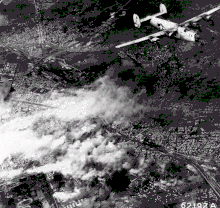
The 376th Air Expeditionary Wing is an inactive wing of the United States Air Force. It was last stationed at the Transit Center at Manas International Airport, Kyrgyz Republic, supporting U.S. and ISAF operations in Afghanistan.

The 512th Rescue Squadron is part of the 58th Special Operations Wing based at Kirtland Air Force Base, New Mexico. It formerly operated the Bell UH-1N Twin Huey and currently operates the Sikorsky HH-60G Pave Hawk and the new HH-60W Jolly Green II helicopters training aircrew conducting search and rescue missions.
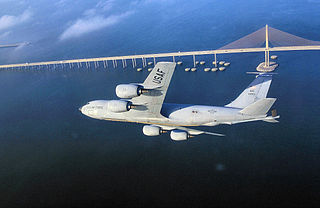
The 91st Air Refueling Squadron is part of the 6th Air Mobility Wing at MacDill Air Force Base, Florida. It operates the Boeing KC-135R Stratotanker aircraft conducting air refueling missions.

The 801st Air Division is an inactive United States Air Force organization. It was assigned to Strategic Air Command (SAC)'s Eighth Air Force at Lockbourne Air Force Base, Ohio, where it was inactivated on 15 March 1965.

The 344th Air Refueling Squadron is a unit of the US Air Force, part of the 22d Air Refueling Wing of Air Mobility Command at McConnell Air Force Base, Kansas. It operates the Boeing KC-46 Pegasus aircraft conducting aerial refueling missions.

The 909th Air Refueling Squadron is part of the 18th Wing at Kadena Air Base, Japan. It operates the KC-135 Stratotanker aircraft conducting air refueling missions.

The 65th Special Operations Squadron is an Air Force Special Operations Command unit which flies the General Atomics MQ-9 Reaper at Hurlburt Field, Florida. The squadron was first activated as the 65th Bombardment Squadron in January 1941, one of the original squadrons of the 43rd Bombardment Group. Following the attack on Pearl Harbor, the squadron participated in antisubmarine patrols until January 1942, when it moved to Australia and the Southwest Pacific Theater. It moved forward with US forces through New Guinea and the Philippines, moving to Ie Shima shortly before V-J Day for operations against Japan. It earned two Distinguished Unit Citations and a Philippine Presidential Unit Citation for combat operations. During this period, a crew from the 65th became the most decorated aircrew in United States history, when their B-17 fought off twenty Japanese fighters during a photo reconnaissance mission. The squadron was inactivated in the Philippines in April 1946.

The 403d Bombardment Squadron is an inactive United States Air Force unit. It was last assigned to the 43rd Bombardment Wing at Carswell Air Force Base, Texas, where it was inactivated on 1 January 1961.

The 415th Flight Test Flight is a United States Air Force reserve unit. It is assigned to the 413th Flight Test Group of Air Force Reserve Command, stationed at Joint Base San Antonio-Randolph, Texas.
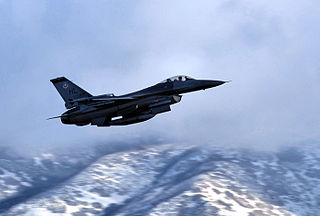
The 514th Flight Test Squadron is a squadron of the United States Air Force, which has been stationed at Hill Air Force Base, Utah since 1973, performing functional flight checks on aircraft undergoing major maintenance.

The 531st Bombardment Squadron was a unit of the US Air Force, first activated during World War II. After training as a heavy bomber unit in the United States, it moved to the Southwest Pacific Theater, entering combat in May 1943, flying combat missions from Australia while attached to the Royal Australian Air Force, earning two Distinguished Unit Citations and a Philippine Presidential Unit Citation. In 1945 it moved forward to the Philippines, then to Okinawa. Following V-J Day, the squadron returned to the Philippines and was inactivated there in February 1946.
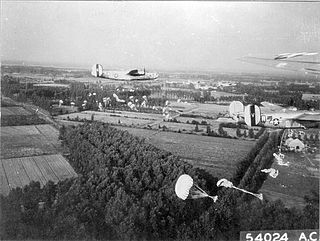
The 506th Bombardment Squadron is an inactive United States Air Force unit. It was last assigned to the 44th Bombardment Wing at Chennault Air Force Base, Louisiana, where it was inactivated on 15 June 1960.

The 343d Bomb Squadron is a United States Air Force Reserve squadron, assigned to the 307th Operations Group. It is stationed at Barksdale Air Force Base, Louisiana.

The 547th Bombardment Squadron is an inactive United States Air Force unit. It was first activated during World War II as a Boeing B-17 Flying Fortress unit. After training in the United States, it deployed to the European Theater of Operations, where it participated in the strategic bombing campaign against Germany, earning two Distinguished Unit Citations. Following V-E Day, the squadron moved to France and was inactivated there in early 1946.

The 513th Electronic Warfare Squadron is a United States Air Force unit assigned to the 350th Spectrum Warfare Group at Eglin Air Force Base, Florida.

The 424th Bombardment Squadron is an inactive United States Air Force unit. Its last assignment was with the 307th Bombardment Wing at Lincoln Air Force Base, Nebraska, where it was inactivated on 1 January 1962.

The 352d Bombardment Squadron is an inactive United States Air Force unit. It was last assigned to the 301st Bombardment Wing at Lockbourne Air Force Base, Ohio, where it was inactivated on 8 June 1964.
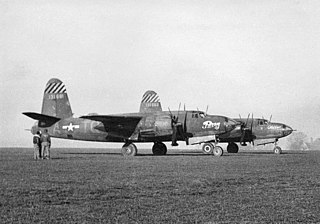
The 969th Airborne Warning and Control Squadron is an inactive United States Air Force unit. It was formed in 1985 by the consolidation of the 559th and 659th Bombardment Squadrons.

The 860th Bombardment Squadron is a former United States Army Air Forces unit that was assigned to the 493d Bombardment Group during World War II. It was part of the last bombardment group to be assigned to Eighth Air Force. It flew combat missions until V-E Day, then returned to the United States for inactivation. In 1985, the squadron was consolidated with the 660th Bombardment Squadron, a Strategic Air Command unit that flew Boeing B-47 Stratojets during the Cold War. Although the two squadrons were consolidated as the 967th Airborne Warning and Control Squadron, they have never been active under that designation.

The 376th Expeditionary Operations Group was a provisional United States Air Force Air Combat Command unit. It was stationed at the Transit Center at Manas International Airport, Kyrgyz Republic, up until 2014.


